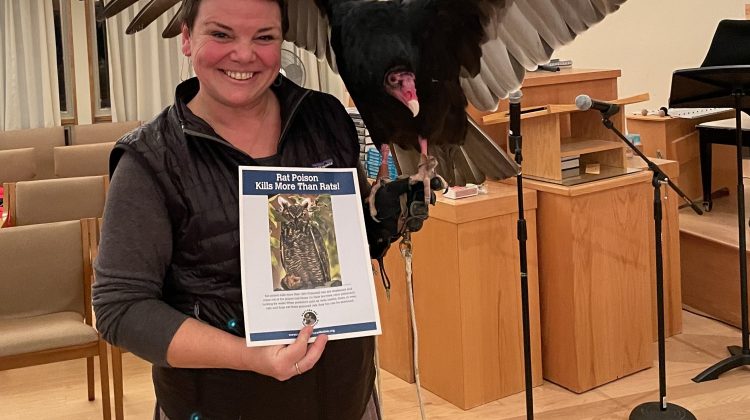The Swampscott Conservancy
On Nov. 29, a barred owl, a red-tailed hawk, and a turkey vulture paid a visit to the Unitarian Universalist Church of Greater Lynn in Swampscott – and I don’t mean outside. Rather, they came right into the church sanctuary. But they were invited! These three birds of prey were part of an informative presentation put on by Tailwinds, a local nonprofit that offers environmental and conservation-education programming.
Sponsored by the church, the Clifton Improvement Association, and the Swampscott Conservancy, the program, which was presented by two of the founders of Tailwinds, Sarah Kern and Linda Noon, gave the adults and kids in attendance not only an opportunity to learn some interesting facts about these remarkable creatures, but to observe them up close.
There can be no argument that the hawk, with his regal countenance, flew away with the “most majestic” award of the night; and the owl, talons down, won the “most adorable” award. But for me, “Greta,” the turkey vulture, was the surprise of the evening, as I never thought I’d find meeting a vulture an enjoyable experience.
Greta, who clearly delighted in showing off her six-foot wingspan, doesn’t have sharp talons and a curved bill to kill her prey like other raptors; she is a scavenger. Like other vultures, she eats carrion (that is, the dead and rotting flesh of animals). And, with her extraordinary sense of smell, she can detect carrion from more than a mile away!
One especially fun fact, particularly for the younger members of the audience, is that, as a defense mechanism, turkey vultures can projectile vomit up to 10 feet away on any bird, animal, or human who gets too close. This ability was not (thankfully) demonstrated during the Tailwinds presentation, though all three birds did occasionally leave deposits of another kind on the floor, which were quickly cleaned up.
Because of what they eat, vultures tend to have a bad reputation, but actually they provide an important service by ridding the environment of dead animals that would accumulate and potentially spread disease. The digestive juices in a vulture’s stomach are extremely acidic, so it can digest just about anything, allowing it to eat carcasses tainted with anthrax, tuberculosis, and rabies without getting sick.
Threat to birds of prey from rodenticides
But, like other birds of prey, there is something turkey vultures can’t ingest, and that’s animals tainted with rodenticides, in particular second-generation anticoagulant rodenticides (or SGARs). Commonly used by exterminators, SGARs are placed in those ubiquitous black bait boxes you see outside buildings. Because SGARs stop the natural blood-clotting process, rodents that eat the bait slowly die. As they sicken, they become an easy target for eagles, hawks, and owls. Unfortunately, these birds will also succumb to death, by a slow internal bleeding.
There are many documented cases of birds of prey being poisoned by rodenticides in Massachusetts and elsewhere. This sad fact was brought to light in a Nov. 9 presentation by Laura Kiesel, wildlife biologist, naturalist, conservation advocate, and founder of Save Arlington Wildlife.
Her presentation, titled “The Rat Poison Problem: How Rodenticides Are Harming Wildlife, Pets, and People,” was also hosted by the church, the Clifton Improvement Association, and the Swampscott Conservancy. If you missed her talk, you can watch it at youtube.com/watch?v=4vGqvM80Yk8
Kiesel explained how numerous birds and other animals are poisoned by SGARs each year, including a Bald Eagle nicknamed “MK,” who was known and loved throughout the Mystic River watershed. And MK was not an isolated case. New studies and reports confirm that these rodenticides are killing an increasing number of birds of prey throughout our larger neighborhood of New England.
How can you help?
First, by becoming educated on the issue. Start by reading the information on Save Arlington Wildlife’s website, savearlingtonwildlife.org
Second, write to your select board or city council, urging it to ban the use of SGARs on municipal-owned properties.
Third, support the following state legislation that can lead to the restriction or banning of SGARs. More information on these bills and how to contact your state legislators can be found at savearlingtonwildlife.org/ways-to-get-involved/
- H.814/S.540 would return power to towns and cities to regulate pesticides by abolishing the state law that currently prevents municipalities from banning or restricting SGARs on private property. You can also urge your town or city to submit a home-rule petition to the state government asking for a waiver from this state law and allowing your community to regulate SGARs.
- H. 825/S.487 An act relative to pesticides (also known as the “Hawkins bill”) would require a state registration database to track SGAR use in the state and promote education and awareness about these poisons. The Animal Legal Defense Fund also has an on-line form you can use to ask your state legislator to support this bill: aldf.org/project/protecting-animals-from-rat-poisons-massachusetts/
Finally, as pointed out on Save Arlington Wildlife’s website, http://savearlingtonwildlife.org/ , there is no comprehensive peer-review data showing that rodenticides like SGARs are actually effective at meaningfully reducing rodents, particularly in suburban communities, and may actually be a contributing factor to rodent infestations. There are alternatives to rodenticides and steps that individuals can take as shown at savearlingtonwildlife.org/alternatives-to-rodenticide/
It’s up to us to speak up for eagles, hawks, owls, and vultures – like Greta – who frequent our neighborhoods, and to care enough to protect them from the lethal effects of poisons like SGARs.
Nature in the Neighborhood is a monthly feature provided by the Swampscott Conservancy and submitted by Conservancy President Tonia Bandrowicz.

